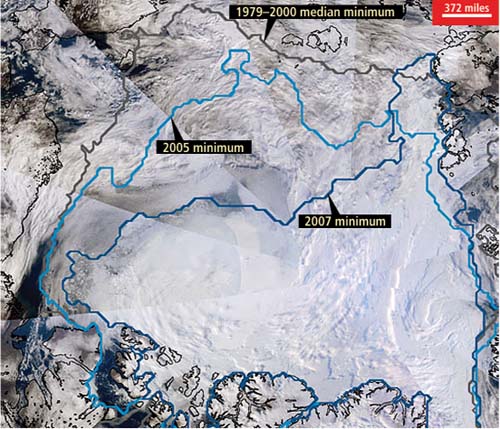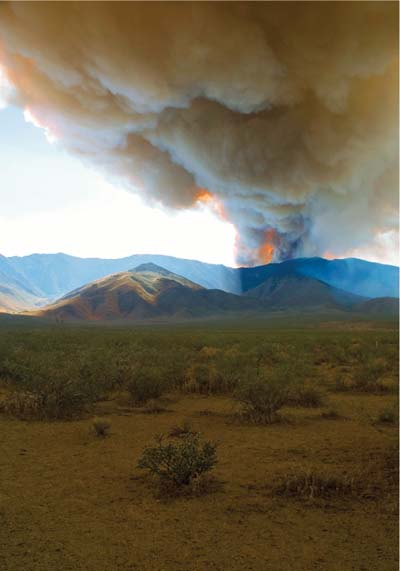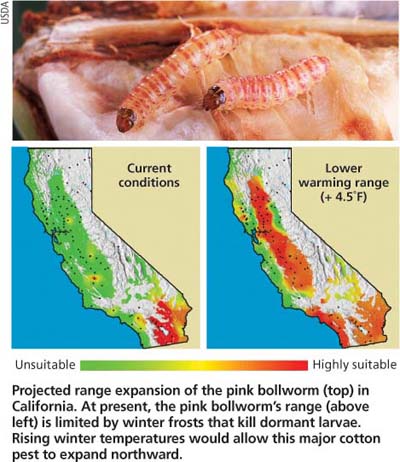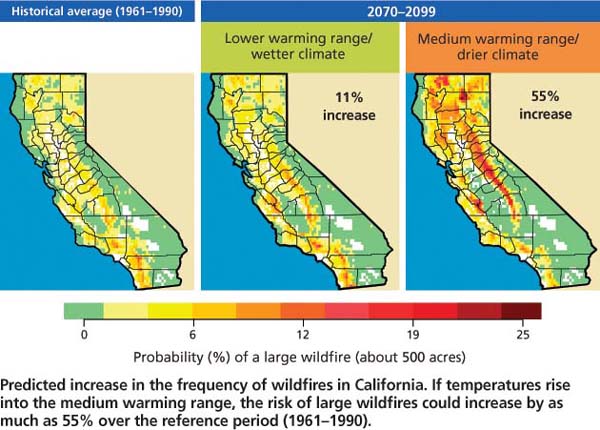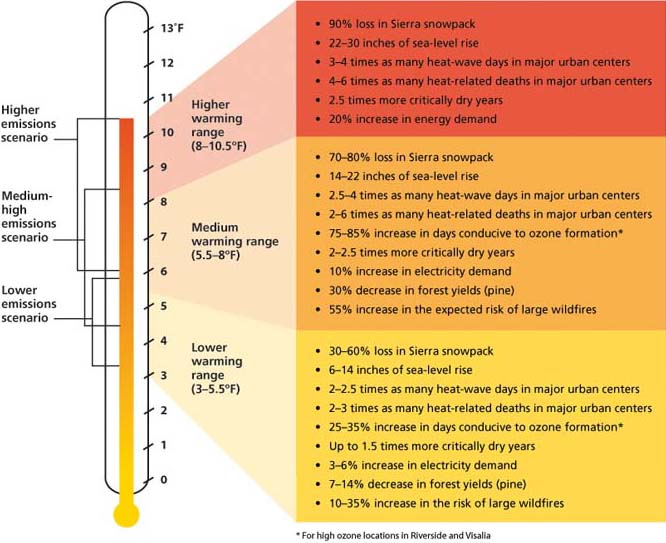All Issues
Climate change affects us all
Publication Information
California Agriculture 63(2):51-53.
Published April 01, 2009
PDF | Citation | Permissions
Full text
Earth's temperature has risen 1°F in the last 100 years — a small number with a profound impact. California's warmer winters and springs have led to reduced snow-pack, increasing the seasonality of water flows and directly affecting our ability to grow plants, produce food and support growing populations. Wildfires are increasing; crop pests are expanding their ranges. “Natural disasters” — such as droughts, Santa Ana winds, tornados, higher intensity rainfall events and fire — are more frequent and severe. Such changes are consistent with trends worldwide.
But climate change up to now is small compared to what is in store. We now know that once carbon dioxide is in the atmosphere, it is there for a long time, perhaps 1,000 years. Even if we reduce our current heat-trapping emissions, the amount of greenhouse gases will continue to accumulate for some time. According to low, medium and high emissions scenarios developed by the Intergovernmental Panel on Climate Change (IPCC), our planet will heat up another 1°F to 2.3°F by 2034 — an accelerating change that will take place over the course of just 25 years, rather than 100.
After mid-century, the three scenarios diverge widely in their predictions (see figure, page 53). Depending on future heat-trapping emissions, there are huge differences in the predicted average heating, ranging from 3°F to 10.4°F by the end of this century — and leading to potentially catastrophic effects such as a sea-level rise of 6 to 30 inches.
On Sept. 15-16, 2007, NASA's Terra satellite observed sea ice and open ocean throughout the Arctic. Shown are the sea-ice minima of 2007, the previous record low in 2005, and the long-term average from 1979 to 2000. The 2007 minimum fell substantially below previous records. Source: Image by Terry Haran, National Snow and Ice Data Center, Univ. of Colo., Boulder.
The degree of heating and resulting climate impact depends largely on what we do now. It matters that we reduce our carbon footprint, use fewer fossil fuels and fertilizers, and learn how to change, manage and mitigate.
Landmark initiatives have already begun in California. The state made history with passage of the Global Warming Solutions Act of 2006 (AB32), promising to reduce global warming pollution to 1990 levels by 2020. In partnership with the state, UC scientists have been leaders in climate-change research for a decade. UC Agriculture and Natural Resources (ANR) scientists are advancing our knowledge of global warming impacts on food production and natural resources. For example:
-
They have found that the use of cover crops leads to increased carbon storage, by as much as 4,000 to 4,500 pounds per acre over standard farming practices.
-
Others are examining how changing climates will modify wildfire activity, which could profoundly affect carbon sequestration as well as forest conservation.
-
Researchers have developed technology that increases drought tolerance in plants, potentially helping farmers around the world to maintain crop productivity.
California's $37 billion agricultural industry will be severely affected by the coming changes. Recent and predicted increases in temperature will have major impacts on where plants can be grown. Changing temperatures will also likely shift the range of native plants, and even cause some to disappear altogether (see page 57).
In this special issue of California Agriculture, UC scientists advance our understanding of how climate change will affect California (see page 59). New research reported suggests a mechanism to explain why initial increases in crop production due to “CO2 fertilization” decline rapidly, a finding with important implications for hunger and nutrition worldwide (see page 67). Additional findings have shown that crops will suffer greater pest losses (see page 73). The numbers and kinds of invasive pests and diseases are increasing because of rising temperatures overall, and because pests consume more of the plant due to higher carbon and lower nitrogen content. In addition, the lack of winter chill periods will allow pests to breed throughout the year.
Editor's note: Barbara Allen-Diaz was among 2,000 scientists recognized for their work on the Intergovernmental Panel on Climate Change (IPCC), when the Nobel Peace Prize was awarded jointly to the IPCC and Vice President Al Gore in 2007. Allen-Diaz's contributions focused on the effects of climate change on rangeland species and landscapes.
Wildfires have become more frequent and widespread in California in recent decades. In July 2002, an 8,600-acre blaze burned near Topaz Lake in Mono County, near the Nevada border in the eastern Sierra Nevada.
Projected range expansion of the pink bollworm (top) in California. At present, the pink bollworm's range (above left) is limited by winter frosts that kill dormant larvae. Rising winter temperatures would allow this major cotton pest to expand northward.
Scientists also describe mitigation options to reduce agriculture's impact on the climate system. For instance, California dairies, the valued producers of 21% of the nation's milk, can help decrease greenhouse-gas emissions and reduce their contributions to global warming (see page 79). UC investigations have shown that management practices can have a significant impact on the amounts of greenhouse gases emitted from cropped fields (see page 84). UC economists have identified sustainable fertilization practices and proposed incentives for farmers to incorporate them into their everyday practices (see page 91). In a review of carbon trading, scientists discuss evolving markets as tools to reduce greenhouse-gas emissions (see page 96).
Climate change will challenge California's natural ecosystems. For example, no Joshua trees will be able to grow in Joshua Tree National Monument in the Mojave Desert. Douglas and white fir forests will likely become dominated by oaks and madrone. These changes also will affect wildlife populations that depend on these ecosystems.
Such profound challenges require not only research — to develop new pest and disease strategies, new cropping systems and better understanding of the changes in timing of flowering and seed production — but also new commitments to education and public outreach. We must foster greater science literacy, enabling people to make informed choices, develop new options and take action at all levels. UC, and specifically ANR, have vital roles in this effort. No single research track or set of actions will be enough to curb the ongoing and complex changes to our climate system. Solutions will require partnerships and will involve tradeoffs — ecological, economic and social.
ANR, with its network of campus-based scientists, Cooperative Extension (CE) specialists and county-based CE advisors, is uniquely situated to identify, examine and deliver solutions. Our system includes a network of 10 Research and Extension Centers located throughout California's various crop production and climatic zones, from the high desert on California's northern border to the highly productive Imperial Valley desert on our Mexican border. These centers retain decades of records on climate, water, crop productivity and biodiversity, among other long-term data sets. All are now invaluable sources of information to project the local effects of changing climate, and to experimentally test new crop options, plant and animal production methods, ways to conserve biodiversity, and options to remain sustainable and viable in a global economy.
In a multipartner project, for example, the UC Berkeley Institute of the Environment has launched the Sustainable Neighborhood project. Funded by the Gordon and Betty Moore Foundation, the project is working in China to design, build and monitor a replicable, transit-oriented sustainable neighborhood that generates all of its energy from on-site renewables (such as wind, solar and biomass); processes all of its sewage, food and green wastes; and recycles all its water. If successful, this innovative project will lead to the first carbon-neutral community of its kind that can be replicated on a massive scale.
Closer to home, Sonoma County has joined America's Fund for Integrated Solutions, a national network of local governments, universities and private partners. In partnership with UC, local businesses and others, the county is integrating more-efficient energy use with retrofits of existing buildings, and seeking incentives for developing new sources of renewable energy from solar, wind and wave power — all coupled with attention to human needs and behaviors.
It will take both individual actions, and partnerships at all scales, to change behaviors, industries and the way we think about our place in the world. Perhaps the biggest challenge is making the paradigm shift from a fossil fuel—based economy to one driven by renewable sources of energy.
There is no time like the present for addressing climate change. The critical players are all at the table: politicians, scientists, technologists, city-county and regional planners, business people, nonprofits and government. We have an administration in Washington, D.C., that has signaled its readiness to make policy and behavior changes to decrease U.S. greenhouse-gas emissions, reduce our dependence on fossil fuels and build green industries with green jobs to help ensure a thriving future. Our planet, and our future, depend on it.
Predicted increase in the frequency of wildfires in California. If temperatures rise into the medium warming range, the risk of large wildfires could increase by as much as 55% over the reference period (1961–1990).
Projected global warming impacts in California, 2070–2099 (as compared with 1961–1990). Warming ranges represent averages predicted from three global climate models (representing different climate sensitivities) and three IPCC global emissions scenarios (see page 61).
Source of figures, pages 52 and 53: Our Changing Climate. California Energy Commission's Public Interest Energy Research (PIER) Program, July 2006. The CEC's second biennial climate-change science report will be posted in early April at: http://www.climatechange.ca.gov/



